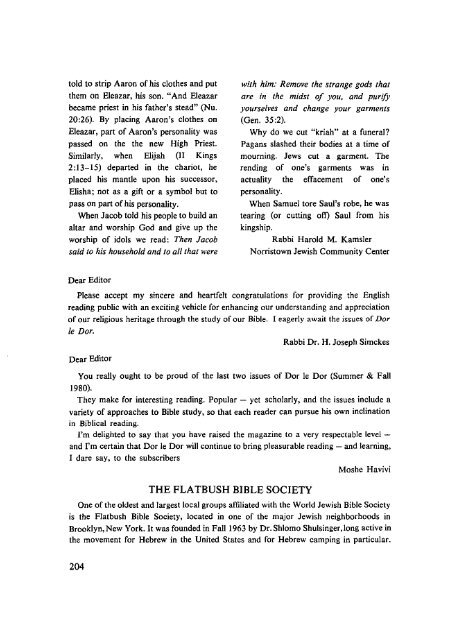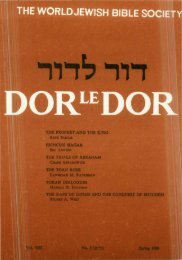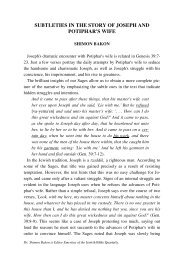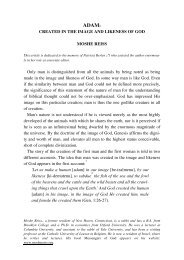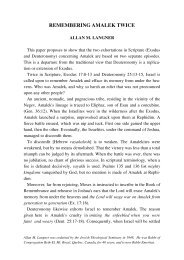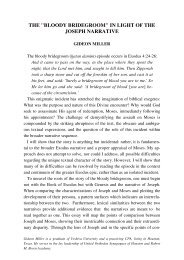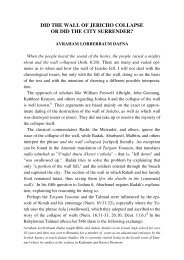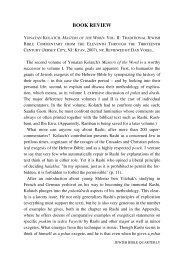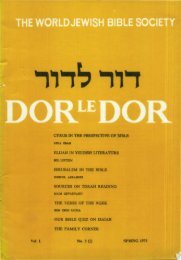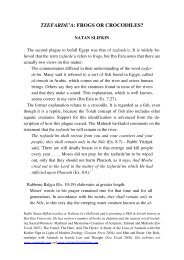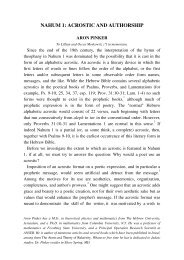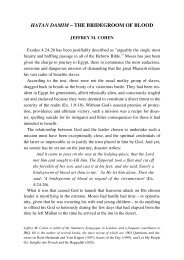The Development of Biblical Prayer - Jewish Bible Quarterly
The Development of Biblical Prayer - Jewish Bible Quarterly
The Development of Biblical Prayer - Jewish Bible Quarterly
You also want an ePaper? Increase the reach of your titles
YUMPU automatically turns print PDFs into web optimized ePapers that Google loves.
told to strip Aaron <strong>of</strong> his clothes and put<br />
them on Eleazar, his son. "And Eleazar<br />
became priest in his father's stead" (Nu.<br />
20:26). By placing Aaron's clothes on<br />
Eleazar, part <strong>of</strong> Aaron's personality was<br />
passed on the the new High Priest.<br />
Similarly, when Elijah (II Kings<br />
2:13-15) departed in the chariot, he<br />
placed his mantle upon his successor,<br />
Elisha; not as a gift or a symbol but to<br />
pass on part <strong>of</strong> his personality.<br />
When Jacob told his people to build an<br />
altar and worship God and give up the<br />
worship <strong>of</strong> idols we read: <strong>The</strong>n Jacob<br />
said to his household and to all that were<br />
Dear Editor<br />
with him: Remove the strange gods that<br />
are in the midst <strong>of</strong> you, and purify<br />
yourselves and change your garments<br />
(Gen. 35:2).<br />
Why do we cut "kriah" at a funeral?<br />
Pagans slashed their bodies at a time <strong>of</strong><br />
mourning. Jews cut a garment. <strong>The</strong><br />
rending <strong>of</strong> one's garments was in<br />
actuality the effacement <strong>of</strong> one's<br />
personality.<br />
When Samuel tore Saul's robe, he was<br />
tearing (or cutting <strong>of</strong>l) Saul from his<br />
kingship.<br />
Rabbi Harold M. Kamsler<br />
Norristown <strong>Jewish</strong> Community Center<br />
Please accept my sincere and heartfelt congratulations for providing the English<br />
reading public with an exciting vehicle for enhancing our understanding and appreciation<br />
<strong>of</strong> our religious heritage through the study <strong>of</strong> our <strong>Bible</strong>. I eagerly await the issues <strong>of</strong> Dor<br />
le Dor.<br />
Rabbi Dr. H. Joseph Simckes<br />
Dear Editor<br />
You really ought to be proud <strong>of</strong> the last two issues <strong>of</strong> Dor le Dor (Summer & Fall<br />
1980).<br />
<strong>The</strong>y make for interesting reading. Popular - yet scholarly, and the issues include a<br />
variety <strong>of</strong> approaches to <strong>Bible</strong> study, so that each reader can pursue his own inclination<br />
in <strong>Biblical</strong> reading.<br />
I'm delighted to say that you have raised the magazine to a very respectable level -<br />
and I'm certain that Dor le Dor will continue to bring pleasurable reading -and learning,<br />
I dare say, to the subscribers<br />
Moshe Havivi<br />
THE FLA TBUSH BIBLE SOCIETY<br />
One <strong>of</strong> the oldest and largest local groups affiliated with the World <strong>Jewish</strong> <strong>Bible</strong> Society<br />
is the Flatbush <strong>Bible</strong> Society, located in one <strong>of</strong> the major <strong>Jewish</strong> neighborhoods in<br />
Brooklyn, New York. It was founded in Falll963 by Dr. Shlomo Shulsinger,long active in<br />
the movement for Hebrew in the United States and for Hebrew camping in particular.<br />
204


